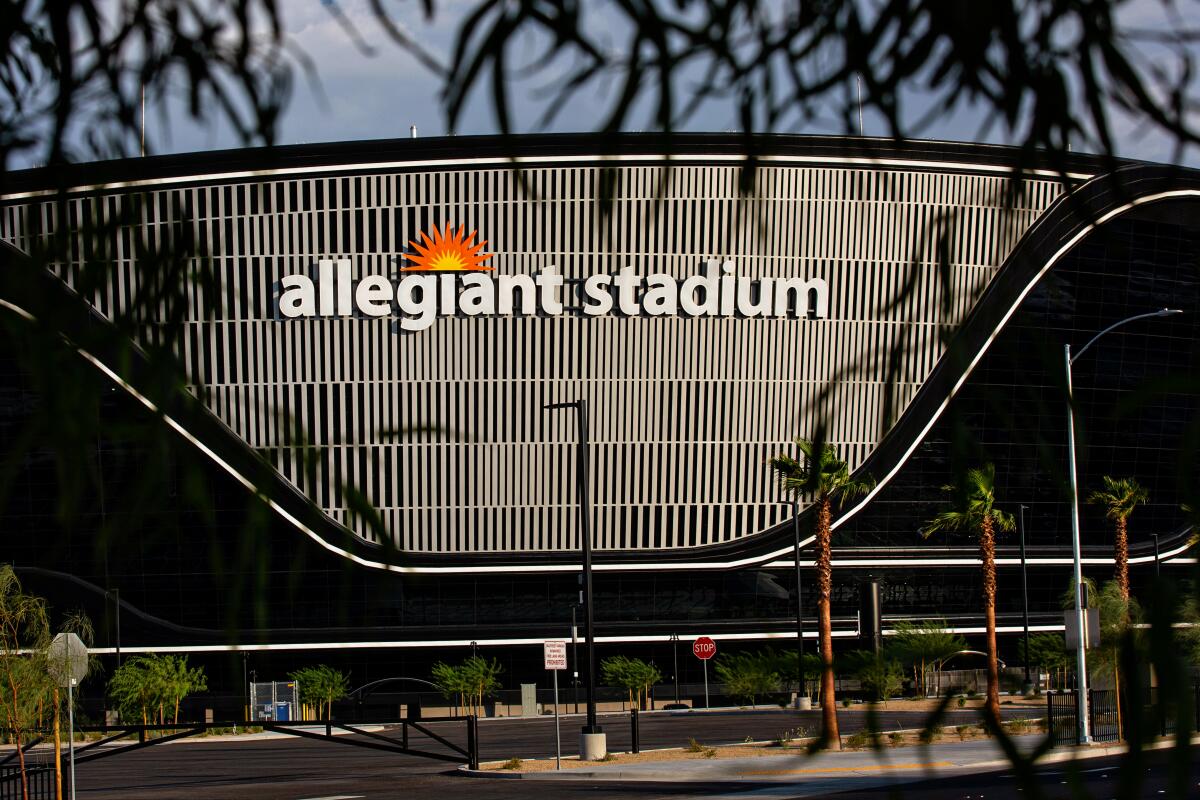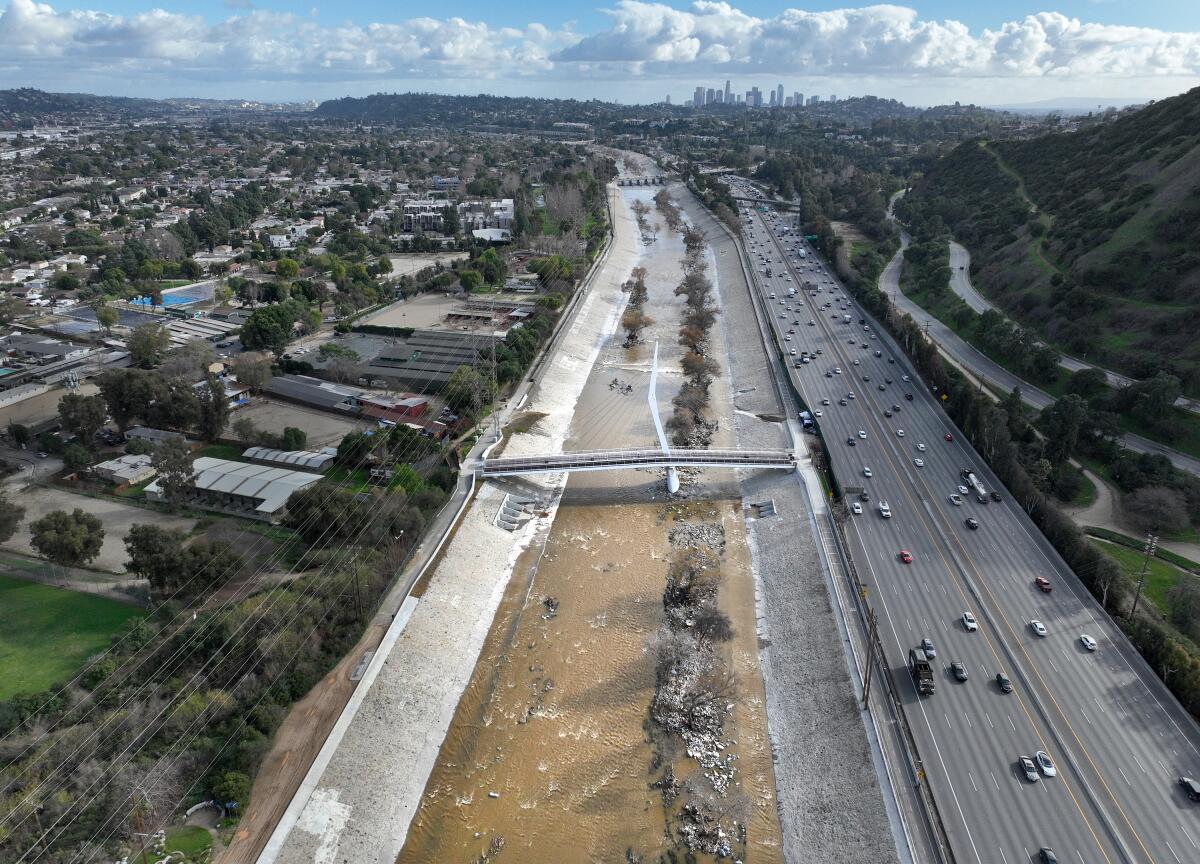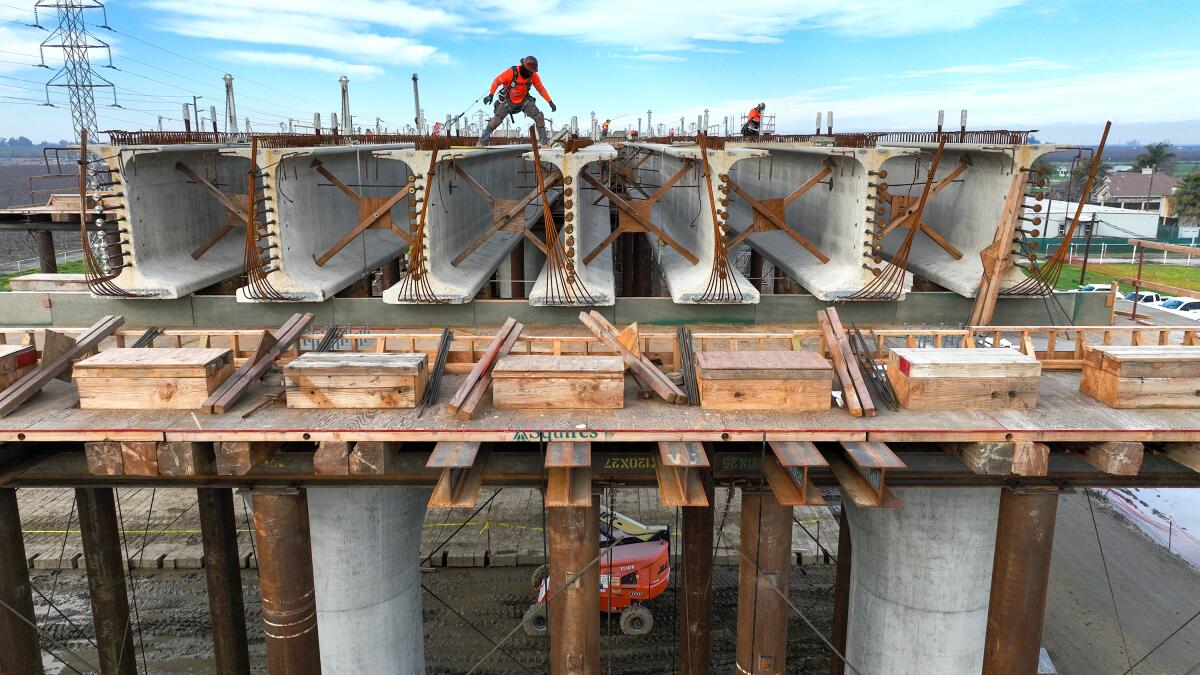Column: Next year’s Super Bowl needs more clean energy ads

“It’s not time to escape. It’s time to engage.”
So said Matthew McConaughey during a 2022 Super Bowl ad for Salesforce, touting the software company’s sustainability efforts. The Salesforce ad was one of 10 commercials that year featuring electric vehicles or other climate change solutions.
This year, by my count, there were only three.
Disappointing? Absolutely. But not cause for despair.
You're reading Boiling Point
Sammy Roth gets you up to speed on climate change, energy and the environment. Sign up to get it in your inbox twice a week.
You may occasionally receive promotional content from the Los Angeles Times.
In better news for folks who care about climate — which includes nearly 90% of the global population, per a study released last week — the Las Vegas Raiders, who hosted Sunday’s game between the San Francisco 49ers and Kansas City Chiefs at Allegiant Stadium, couldn’t stop bragging about how it would be the first Super Bowl powered by 100% renewable energy. Allegiant has a 25-year contract to buy electricity from a new solar farm in the desert not far from Vegas, just up Interstate 15.
“People sometimes get nervous about renewable power, because they’re not sure if it’s going to be reliable. The fact that renewable power can power a facility like this should speak volumes about what can happen in other communities,” said Jennifer M. Granholm, President Biden’s energy secretary, during a visit to Allegiant featured on CBS Mornings.
Those of you well versed in how the power grid works may be grumbling about how electrons don’t flow directly from a particular power plant to an individual energy user, so it’s an exaggeration to say the Super Bowl was powered by 100% clean energy.
And, yes, you would technically be right. Without solar panels on-site, Allegiant Stadium is pulling electricity from the larger power grid — which in Nevada includes a lot of solar power but also even more natural gas, a major contributor to climate change.
But let’s not let the perfect be the enemy of the good news.
Even though Allegiant continues to draw on the power grid, its contract is the type of deal that helps solar and wind farms get built — increasing the supply of renewable electricity on the grid for everyone. Even better, the new solar project selling electricity to Allegiant is paired with batteries to store sunlight for after dark.
And as Anna Jane Joyner noted when I asked her about the Super Bowl, it’s a big deal that the NFL — whose fan base “definitely runs more moderate to conservative,” in her words — has seemingly put its marketing muscle behind 100% clean energy.
“That suggests that they’ve done market research and figured out this is something their viewers are excited about and want to see more of,” said Joyner, a storytelling consultant who founded the nonprofit consulting firm Good Energy.

The dearth of climate and clean energy ads was still unfortunate.
Of the 59 commercials, just two put electric vehicles front and center: a BMW spot starring Christopher Walken and a Kia ad that showed how EV batteries can serve as a backup power source. A third ad briefly featured Volkswagen’s newest electric car.
And in a repeat of last year’s disappointing showing, there was none of the creativity or vision on display in 2022.
I’ve said it before, and I’ll say it again: If we want to avoid total climate catastrophe, we’ll need the world’s storytellers — ad agencies and their clients, Hollywood film and TV producers, writers and artists of all kinds — to start doing their part to make clean energy a priority. There’s almost certainly no way to get to 100% clean energy by 2035 — President Biden’s goal, and a target endorsed by many scientists and activists — without more stories that help people see it’s possible.
“When you said 100% clean electricity by 2035, I’m like, ‘Wow, that’s really not that far away,’” CBS News correspondent Jericka Duncan told one of her colleagues at the end of the Allegiant Stadium segment last week.
No, it’s not that far away. We’ve got 11 Super Bowls left to make it happen.
On that note, here’s what else is happening around the West:
TOP STORIES
Stop me if you’ve heard this one: Earth just experienced its warmest January on record, marking eighth straight months of unprecedented heat. Details here from the New York Times’ Raymond Zhong and Elena Shao, who note that daily sea surface temperatures also reached an all-time high as February got underway. In Los Angeles, some of the most intense heat — and also the most drenching storms — have slammed the San Fernando Valley neighborhood of Woodland Hills. My L.A. Times colleagues Summer Lin and Salvador Hernandez talked with local residents about how the climate crisis is affecting them.
The Biden administration is tightening national limits on soot pollution, with the Environmental Protection Agency saying its new rule will save thousands of lives each year. Unfortunately, most Californians live in areas that are still out of compliance with the old rule, The Times’ Tony Briscoe writes. In other air pollution news, Tony reports that an L.A. County supervisor is urging a landfill operator to pay for the relocation of nearby residents as an underground garbage fire spews noxious fumes.
Climate news outlet Grist has a powerful investigation showing that more than a dozen universities continue to rake in huge amounts of money from Western lands taken from tribal nations — with the money often coming from oil and gas leasing. “Extractive industries are filling public university coffers on stolen land,” the reporters conclude. And although fossil fuel extraction has done a lot more damage to Indigenous lands than renewable energy projects have, it’s important to recognize that no energy source comes consequence-free. Just look to Washington state, where federal officials have recommended approval of a pumped storage hydropower plant, per Northwest News Network’s Courtney Flatt. Supporters say the project would help keep the lights on without fossil fuels; tribal nations say it would destroy a sacred area.
CALIFORNIA STORMS

The concrete-lined Los Angeles River did its job last week, protecting the region from even worse floods. Now we have to start capturing more water before it rushes out to the Pacific during future storms — a crucial strategy for avoiding shortages as climate change worsens, The Times’ Hayley Smith writes. And even as we continue to depend on the L.A. River for flood control — which will only get harder for the concrete channel as global warming brings more intense rainfall, my colleague Louis Sahagún reports — we also shouldn’t lose sight of the environmental and human benefits of restoring the river to something resembling its natural state. Rong-Gong Lin II wrote about that conundrum.
Exactly how big a role did climate change play in fueling last week’s storms? My L.A. Times colleague Ian James has a great explainer on what we do and don’t know — and on the bigger-picture reality of rising temperatures bringing heavier rain. Hayley Smith, meanwhile, wrote about what comes next for the Golden State, amid signs that La Niña — which tends to load the dice for drought conditions — could be in store. And here are some fascinating visuals from L.A. Times graphics and data journalist Paul Duginski showing how Southern California’s king tides are offering us a preview of climate-driven sea level rise.
There are lots of ways we need to start preparing our lives, and our cities, for a fast-arriving future of heavier downpours. For instance, we don’t want millions of gallons of sewage pouring into the ocean every time it rains, or mudslides that threaten to tear homes from their foundations, or widespread power outages. A lot more Californians may need to purchase flood insurance, a topic my colleague Sam Dean explores here. One silver lining: We may see a second straight year of strong energy production at hydropower dams, limiting the need for planet-warming fossil fuels, as the San Diego Union-Tribune’s Rob Nikolewski reports.
THE ENERGY TRANSITION
The fight over where to build renewable energy continues to heat up, with at least 15% of U.S. counties in effect halting the development of large-scale solar farms, wind turbines or both. That’s the key finding of this excellent investigation by USA Today, which sheds light on the community opposition that has become one of the biggest obstacles to clean energy. Speaking of which, Latitude Media’s Erin Hardick has an ineresting look at what the Biden administration is doing to try to help solar and wind developers build greater community buy-in. Arizona certainly isn’t helping; state officials just started the process of scrapping the state’s renewable energy mandate, which wasn’t much to begin with and may now go away entirely.
Here in California, meanwhile, Gov. Gavin Newsom is for the first time using a new state law to limit how long opponents of a planned desert solar farm can keep the project tied up in court. The Desert Sun’s Janet Wilson has the story, writing that Newsom granted the request of developer Intersect Power to limit environmental appeals of its Easley solar project to 270 days. It’s worth noting that there are steps solar companies can take to make their projects more wildlife-friendly. The New York Times’ Catrin Einhorn wrote about some of those steps in a story focused on the grasslands of northern Arizona.
Rooftop solar isn’t perfect, either. Pacific Gas & Electric recently tested a “virtual power plant” with home solar installer Sunrun, using a network of thousands of houses with rooftop panels and batteries to supply electricity to the broader power grid — and although valuable lessons were learned, the test didn’t go as well as expected, Latitude Media’s Maeve Allsup reports. Putting big solar farms on previously disturbed lands could also help avoid habitat destruction. That’s what the Biden administration is doing in Nevada, trying to get a solar farm built on lands formerly used for nuclear bomb tests, Reuters’ Timothy Gardner reports.
POLITICAL CLIMATE

There’s historically been a lot of opposition to high-speed rail in California’s Central Valley, where landowning farmers — who tend to lean Republican — dominate the political landscape. But as construction jobs are created and rail infrastructure gets built, the tenor of the conversation has started to shift, my L.A. Times colleague Melissa Gomez reports. Also of relevance to the Central Valley: Appointees of Gov. Gavin Newsom are finally out with a proposal to ban fracking, three years after they issued their last fracking permit. The proposal would almost exclusively affect Kern County, per the Bakersfield Californian’s John Cox. In another sign of trouble for Kern County oil, Cox reports that the state’s second-largest oil producer is once again being sold, with the purchase price dropping from $4 billion last year to $2.1 billion now.
California’s decade-old plastic bag ban isn’t working, as anyone who’s gone to the grocery store probably knows. So state lawmakers are trying again, proposing new legislation that would close a major loophole in the original law, The Times’ Susanne Rust writes. “Basically what happened is that plastic bag companies invented these thicker plastic bags that technically meet that definition of reusable but are clearly not being reused,” one activist told Susanne. Also in Sacramento, CalMatters’ Alejandro Lazo reports that several legislators have proposed a $1-billion bond to help pay for offshore wind infrastructure at ports.
The International Code Council keeps working quietly to help the natural gas industry undermine clean energy rules for new homes. Even to me, a bona fide energy nerd, the name “International Code Council” sounds boring, so I’m glad HuffPost’s Alexander C. Kaufman has continued investigating the important but under-the-radar consortium. For those of you who may be interested in switching out your gas heater and stove for climate-friendlier electric appliances, Canary Media’s Alison F. Takemura wrote about a cool new tool that helps you figure out how to ditch gas. And if you’re worried you can’t cook a good pizza with an electric oven? There’s a Denver pizzeria proving otherwise, the Colorado Sun’s Michael Booth reports.
WESTERN WILDLIFE
Federal wildlife officials will study whether a tiny snail in the Nevada desert ought to be protected under the Endangered Species Act. Conservation activists are worried the Kings River pyrg — great name for a snail — could be threatened by a massive lithium mine currently under construction, as Hannah Northey and Michael Doyle report for E&E News. In other lithium news, San Diego State University broke ground on a new science lab in the Imperial Valley that will train students for lithium extraction jobs at the Salton Sea, per Gary Robbins at the San Diego Union-Tribune. (See my previous coverage of Salton Sea lithium here.)
Federal wildlife officials have rejected a plea from conservation groups to restore Endangered Species Act protections for gray wolves in the northern Rocky Mountains. The rejection “allows state-sanctioned wolf hunts to continue in Idaho, Montana and Wyoming,” the Associated Press’ Todd Richmond and Matthew Brown report. “Federal officials estimated the wolf population in the region that also includes Washington, California and Oregon stood at nearly 2,800 animals at the end of 2022.” More than a dozen conservation groups are planning to sue the feds over their decision, Amanda Eggert reports for Montana Free Press.
Should we be protecting pinyon-juniper woodlands on Western public lands, or tapping them for wood-based biofuel? My L.A. Times colleague Louis Sahagún explored the debate as it’s playing out in eastern Nevada, writing that while conservationists think we ought to be protecting these ecologically rich landscape, many ranchers see pinyon pines and juniper trees as “a highly flammable and invasive scourge” that can fuel wildfires. In other wildfire news, a U.S. Forest Service “burn boss” is facing criminal charges in Oregon over a prescribed fire that got out of control and scorched a few dozen acres of a private ranch, Inside Climate News’ Grant Stringer reports. Scientists say we need a lot more prescribed burns to prevent larger, more destructive blazes; if the people responsible for setting and managing those fires are afraid of getting arrested, that probably won’t help.
ONE MORE THING

Sick of reading news articles? I get it. There are so many of them. They’re frequently discouraging.
How about getting your news from a sheep puppet instead?
The L.A. Times’ resident puppeteer, Safi Nazzal, has a new video explaining California’s snow drought — and the role played by climate change — through his sheep puppet, Judeh. Safi and Judeh also explored the need for more stormwater capture.
We’re doing our best here at The Times to keep bringing you the climate and environmental stories you need to hear, even after recent layoffs and other challenges facing the news business. Please help us keep doing this work with a subscription.
This column is the latest edition of Boiling Point, an email newsletter about climate change and the environment in California and the American West. You can sign up for Boiling Point here. And for more climate and environment news, follow @Sammy_Roth on X.
Toward a more sustainable California
Get Boiling Point, our newsletter exploring climate change, energy and the environment, and become part of the conversation — and the solution.
You may occasionally receive promotional content from the Los Angeles Times.




